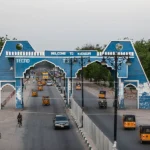The Federal Government settled for the reconstruction of the old Eastern narrow gauge from Port Harcourt to Maiduguri due to the non-availability of funds for the standard gauge, Daily Trust has learnt.
While it would cost a whopping $13bn to construct a new standard gauge, the reconstruction of the old narrow gauge which was flagged off last week would cost $3.2bn.
- Kidnappers of Kaduna students release video, demand N500m
- REVEALED: Six months pregnant lady among victims kidnapped at Kaduna school
There has been criticism in some quarters over the decision to construct narrow gauge in the Eastern corridor at a time the government was doing faster and more modern standard gauge trains across the country.
However, findings showed that the federal government was in dilemma over the huge cost of building a new standard gauge when the narrow gauge has become moribund for years.
A decision was however arrived at to reconstruct the old narrow gauge which links 12 states while a new standard gauge line would be constructed when the funds are available.
Besides, the Federal Government felt the 2,044-kilometer line cannot be left eternally moribund hence the decision to reconstruct it to revive the rail system in the Eastern corridor.
But speaking with our correspondent, the Managing Director of the Nigerian Railway Corporation (NRC), Engr. Fidet Okhiria said the new line would not just be a narrow gauge but an “improved narrow gauge.”
He also gave a hint on the funding for standard gauge which left the government with no option than to rebuild the old eastern narrow gauge.
He said, “If you look at the figure, this one is $3.2bn and the standard gauge is $13.4bn, to source for $13bn plus would take some time.
“People don’t know that the Lagos-Ibadan was initiated and started in 2006 and look at when the fund was raised for it. But the present government said we have to have something running as we also have something running on the western axis on the narrow gauge. Today we still run on the narrow gauge and we are still maintaining it.
“So in order to bridge the gap, do something quickly on the narrow gauge or else people will forget about the rail system on the Eastern corridor. The standard gauge project is still alive and kicking and we are still discussing possible finances.”
‘Narrow gauge not inferior to standard gauge’
While featuring on an NTA programme over the weekend, Minister of Transportation, Mr. Rotimi Amaechi also explained that the Eastern rail line was going to have both the Narrow Gauge and the Standard Gauge.
He stated that as it stands now due to the cost of the standard gauge and what is feasible to embark on based on the time frame, it was cheaper to rehabilitate the narrow gauge which was about $3.2billion dollars which can be delivered within the approved time frame.
He said, “The Standard Gauge line is between $11 to 14billion dollars to construct on the Eastern flag, the standard gauge as designed in Nigeria is 150km design speed, operational speed is 120km, what is the difference between 120km and 100km? The Narrow Gauge is about $3.2billion dollars at 100km Per hour.
“The Standard Gauge which is $11bn to $14billion is 120km per hour. So if you take off with the standard gauge, let’s say to Damaturu, you will arrive 20 minutes before me that used the narrow gauge.
“The Narrow Gauge is cheaper at $3billion against the $11 to 14billion dollar to construct the standard gauge. Why we did not get the approval for the Narrow Gauge on time was because the President insisted on the standard gauge from Port Harcourt-Maiduguri, my argument was if I can achieve the same length of rail with $3billion dollars why not take that first until when we get money, we can now go for the standard gauge.
“Which made him approve the standard gauge as designed but until we get the money because if we continue to wait until we get the $11bn to 14billion dollars, we may not be able to construct the Eastern flag before we leave the government.”
‘Project to generate 20,000 jobs’
According to him, the Eastern rail line would generate between 20,000 and 50,000 jobs aside businesses that will open up along the rail corridor.
He said: “Let us look at the economic benefits, in the course of doing the feasibility of this project, that is when I discovered that there are so many natural resources on that track, iron ore all over the North East, there is Coal between Benue and Enugu.
“What this does is that it provides logistics for the movement of such natural resources or value addition. You have access to the sea through a cheap means of transportation, because the construction of the rail line from here to Maiduguri is about 1000 km.
“The minimum I expect they can employ is between 20,000 and 50,000 workers, if we must achieve it and at the conclusion of construction, imagine how many workers will be employed at the industrial park at the seaport.”

 Join Daily Trust WhatsApp Community For Quick Access To News and Happenings Around You.
Join Daily Trust WhatsApp Community For Quick Access To News and Happenings Around You.
